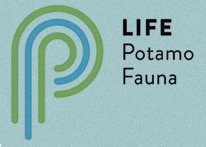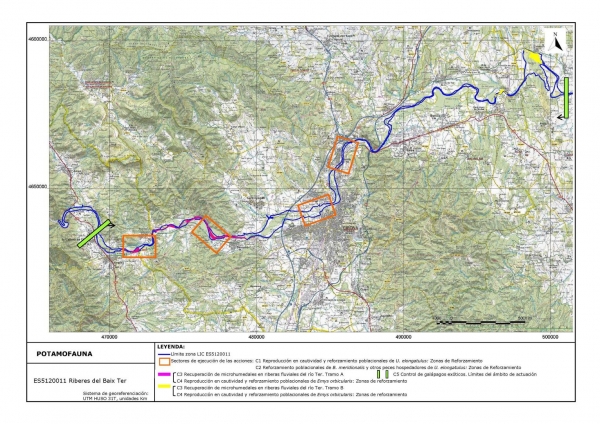Riparian habitats of the Lower Ter
Area: 409.830 hectares
The Natura 2000 area Riparian habitats of the Lower Ter (ES5120011) includes the Area of Natural Interest of the Canet Island, in the Plan for Areas of Outstanding Natural Beauty of the Government of Catalonia but represents only 0.08% in relation to the total. This same area is also listed by the Government as a NatureReserveWildlifeCanetIsland. Riparian habitats of the Lower Ter area is located on the flat that opens after circulating among the ranges of Serralada Transversal and Guilleries.
It is a predominantly sedimentary area with little or no relief and extends to the sea. The Quaternary sedimentary contributions caused by river itself is below 150 m. above the sea level. Here the river, which begins after the system of large-Sau-Susqueda Pasteral Reservoirs gives a drastic flow regulation and is affected by a transfer of water in the large urban areas of Catalonia since the end of the decade of 1960. Thus, in this area there is a remarkable alteration of natural hydrological systems. It is a space where there is a mosaic of natural formations between Mediterranean character or edafophogenic (sub-Mediterranean oaks, riparian forests, marsh plant formations, etc.) and related to agricultural activity. The diversity of environments lets to the existence of numerous natural habitats, some of which hold priority and rich flora and fauna.
The working area of the project does not include all of the SCI space, but a big part in this space is eminently river. Here the project area focuses only on streams and rivers, involving an area centered around these environments in which they live aquatic species objective of the project.
The river Ter is currently regulated under the big reservoirs located in its middle area. The dynamics of the river has changed dramatically, which determines the configuration and current state of river ecosystems and habitats. The decrease in both the average flow as major avenues regenerative power has stabilized longitudinal flow of the river in a virtually fixed position, and having killed the dynamic creation of new oxbows or meandering river.
On the other hand, has reduced the amplitude average stretch of the river. All this explains that gradually reshaped the river habitats have seen their relative position and total length. Some old river habitats virtually disappeared. This is the case of riparian wetlands associated fluvial dynamics, which have almost completely disappeared, including the habitat of European interest code * 3170.
The areas of activity along this stretch of Ter include a conspicuous diversity of river habitats, among which include habitats of riparian forests of Alnus glutinosa (91E0 *), gallery forests of Salix alba and Populus alba (92A0 ) and Mediterranean temporary ponds (* 3170). The recovery of these habitats, especially microhabitats as temporary ponds is necessary to restore the habitat of European interest code * 3170 and encourage critical species in the SCI, such as amphibians and Emys orbicularis. It is necessary to note that the Mediterranean temporary ponds (* 3170) are a very rare habitat at the regional, national and EU areas. However, the current state of conservation of these habitats is not satisfactory and there is an imminent risk of deterioration or disappearance of some of them due to human factors (inadequate planning, logging, altered fluvial morphodynamics) as well as biotic factors (exotic species, regeneration difficulties, phytopathology, etc.). The enclave remains a remarkable representation of amphibians, fish and birds related to the river environment, although some of them are in decline. It is necessary to mention also the recent recolonization of Otter (Lutra lutra) in this section. Among the birds, Ixobrychus minutus, Egretta garzetta, Ardea cinerea, Ardea purpurea and Nycticorax nycticorax species are regular visitors to the area.
While in the LIFE Nature project Riparia-Ter (LIFE08 NAT/E/000072) was performed to retrieve this type of habitat, particularly in two sectors of the banks of the Lower Ter LIC, the characteristics of wetlands are created to set different in this project, and it will be placed in new sectors. We should also note that the current hydrological dynamics of the river Ter makes feasible the sudden appearance of wetlands, and the recovery of several species of European interest objective of this project depends largely on these environments.
The importance of the populations of the banks of the Lower Ter species objective of this project is remarkable, although difficult to quantify in terms of demography.
the Naiad Unio Elongatulus. Its regression in catalan basins has been dramatic. The population of this species existing in Lower Ter is one of the few spots (<10) that are known in the basin of the River Ter and the whole basin of northeastern Catalonia. Apparently, despite being seriously threatened and in obvious decline, there are numerous locations with scattered Unio elongatulus with the lower part of the River Ter, in the main channel of the river and irrigation channels and ditches in the environment. There are some studies that took place to know the distribution and abundance of these naiads the Lower Ter showing a wide distribution, with a low abundance and some midpoint location with some small items (natural reproduction). There are many threats to these populations, especially stemming from the disappearance of native fish species and increasing Anodota woodiana and other exotic bivalve such as Corbicula fluminea.
Actions planned are stocking with captive-bred breeding laboratory naiads in Consorci de l’Estany developed in a previous project (LIFE08 NAT / E / 000078) from parental individuals of the same river basin. Since there may be some genetic differentiation between basins and sub-basins, the individuals used must proceed from the own space within the same watershed. In each of these areas will choose between 2 and 4 sectors where reinforcements will be conducted with youth naiads and infestations of wild fish with naiads will be done. These sectors will be allocated based on information previously available on the general state of the rivers in the area of general scope of the project and the current understanding of the requirements of the species and the status of their populations. Chosen stretches of river with a stable river channel morphology, suitable courses, good water quality, scarce natural hydrological stress, general good ecological status and the presence of at least one species of native fish host, among other criteria.
Mediterranean Barbel (Barbus meridionalis). This species is experiencing a gradual decline in the whole distribution area in he world, located in southern Europe. While still maintaining stable populations in dense areas, in some rivers has disappeared from many sectors, especially along the main river axes previously occupied. In the basin of the River Ter, Barbus meridionalis has still stable populations in some areas, but overall is in decline, having disappeared completely from the lower course of the river.
The recovery actions for Barbus meridionalis in the Lower Ter River depend on the relationship with stock recovery Unio elongatulus. In the places where the repopulatation with youth Unio elongatulus bred in captivity will be and aim, the the composition of fish will be studied, to ensure the presence of the guests for naiads as Barbus meridionalis or Squalius laietanus. In case of not having the presence of these species, repopulation will be done with Barbus meridionalis.
Pond turtles (Emys orbicularis and Mauremys leprous) and amphibians like Marbled Newt (Triturus marmoratus), Mediterranean Tree frog (Hyla meridionalis), Natterjack Toad (Bufo calamita), Western Spadefoot Toad (Pelobates cultripes)... These species have experienced a significant decline in Spain and throughout Europe. In the case of Emys orbicularis in Catalonia, its decline has been particularly sharp, having almost completely disappeared from most of their respective occupation original zones. In the case of Mauremys leprosa spontaneous recovery is occurring, and some specimens can be observed on the shores of Lower Ter. Worse is the situation of Emys orbicularis in the whole of Catalonia, where there are currently only five populations, two of them in critical condition. In fact, the most optimistic estimates suggest that there are fewer than 1,000 individuals in the wild throughout Catalonia. Thus, the recovery of these two turtles in the river Ter, where have ample suitable habitat, it is of considerable importance and priority for long-term conservation Catalan scale.
In this context, a previous project LIFE04 NAT / ES / 000059 Improvement Recovery habitat of amphibians and Emys orbicularis in the Baix Ter 2005-2008 were performed actions for the conservation of Emys orbicularis and amphibians areas. The project to restore some habitats temporary ponds in the LIC-Montgrí The Medes-Bas Ter (ES5120016) later repopulated with Emys orbicularis bred in captivity for breeding center in Albera (“Centre de Reproducció de Tortugues de l’Albera”). This is in direct contact with SCI Banks of the Lower Ter, which this project would be a continuation or an extension of the distribution area of Emys orbicularis around the river Ter, as well as indirectly populations of amphibians. The juvenile specimens of Emys orbicularis come from the same parental individuals, and therefore part of the same population, promoting the exchange between them along the same watercourse. The adaptation of the Lower Ter copies Wetlands was very good, and it was found to reproduce naturally in 2011, a situation that ensures the establishment of a stable core player in the area. At the same time it is necessary to make catches by exotic species of turtle trapping.

















